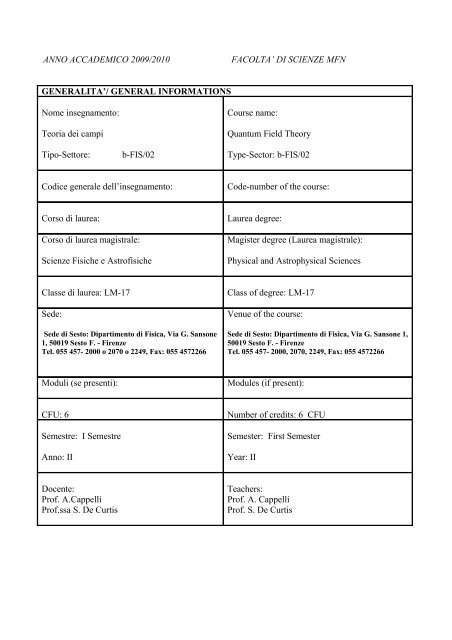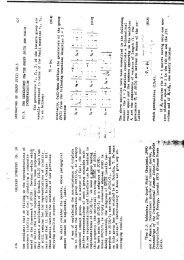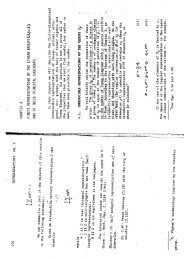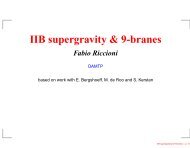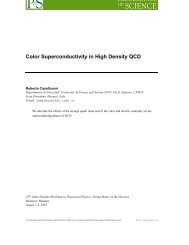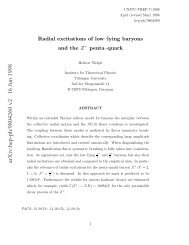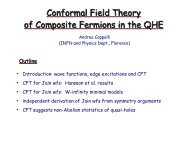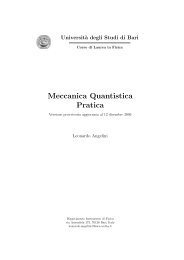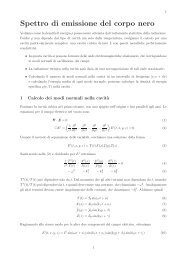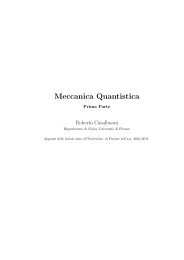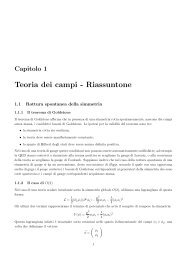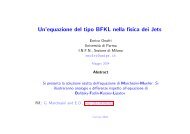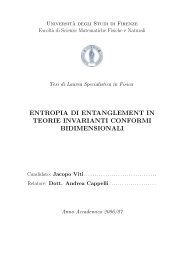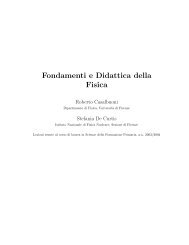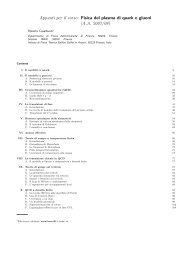Program - Florence Theory Group
Program - Florence Theory Group
Program - Florence Theory Group
You also want an ePaper? Increase the reach of your titles
YUMPU automatically turns print PDFs into web optimized ePapers that Google loves.
ANNO ACCADEMICO 2009/2010 FACOLTA’ DI SCIENZE MFN<br />
GENERALITA’/ GENERAL INFORMATIONS<br />
Nome insegnamento:<br />
Teoria dei campi<br />
Tipo-Settore: b-FIS/02<br />
Course name:<br />
Quantum Field <strong>Theory</strong><br />
Type-Sector: b-FIS/02<br />
Codice generale dell’insegnamento: Code-number of the course:<br />
Corso di laurea: Laurea degree:<br />
Corso di laurea magistrale:<br />
Scienze Fisiche e Astrofisiche<br />
Magister degree (Laurea magistrale):<br />
Physical and Astrophysical Sciences<br />
Classe di laurea: LM-17 Class of degree: LM-17<br />
Sede:<br />
Sede di Sesto: Dipartimento di Fisica, Via G. Sansone<br />
1, 50019 Sesto F. - Firenze<br />
Tel. 055 457- 2000 o 2070 o 2249, Fax: 055 4572266<br />
Venue of the course:<br />
Moduli (se presenti): Modules (if present):<br />
Sede di Sesto: Dipartimento di Fisica, Via G. Sansone 1,<br />
50019 Sesto F. - Firenze<br />
Tel. 055 457- 2000, 2070, 2249, Fax: 055 4572266<br />
CFU: 6 Number of credits: 6 CFU<br />
Semestre: I Semestre<br />
Anno: II<br />
Docente:<br />
Prof. A.Cappelli<br />
Prof.ssa S. De Curtis<br />
Semester: First Semester<br />
Year: II<br />
Teachers:<br />
Prof. A. Cappelli<br />
Prof. S. De Curtis
OBIETTIVI FORMATIVI/EDUCATIONAL OBJECTIVES (learning outcomes)<br />
Conoscenze: Fondamenti di teoria dei gruppi, e<br />
di fenomenologia delle particelle elementari,<br />
basi della teoria dei campi moderna,<br />
quantizzazione di campi liberi.<br />
Competenze acquisite: Diagrammi di<br />
Feynman, calcolo di sezioni d’urto a livello<br />
albero in QED<br />
Capacità acquisite (al termine del corso):<br />
rinormalizzazione di teorie di campo e suoi<br />
effetti fisici. Fisica del modello standard delle<br />
interazioni elettrodeboli<br />
Knowledge acquired: Basic knowledge of<br />
group theory, phenomenology of elementary and<br />
modern quantum field theory. Quantization of<br />
free fields.<br />
Competence acquired: Feynman diagrams,<br />
evaluations of tree level cross sections in QED<br />
Skills acquired (at the end of the course):<br />
Renormalization of quantum field theories and<br />
physical effects. Physics of the Standard Model<br />
of electroweak interactions<br />
Lingua di insegnamento: italiano, inglese Language of instructions: Italian, English<br />
Contenuti del corso (programma<br />
dettagliato):<br />
-Path-integral in teoria dei campi, metodi funzionali<br />
e serie perturbativa<br />
-Relazione tra teoria dei campi euclidea e meccanica<br />
statistica. Azione effettiva<br />
-Invarianza di gauge. Path-integral di QED.<br />
Identita` di Ward<br />
-Rinormalizzazione della QED a 1-loop. Effetti<br />
fisici della rinormalizzazione<br />
-Introduzione al gruppo di rinormalizzazione.<br />
Equazione di Callan-Symanzik e costante d'accoppiamento<br />
mobile<br />
-Introduzione alla QCD: liberta' asintotica e al<br />
modello a partoni.<br />
- Interazioni deboli<br />
- Teorie di gauge non-abeliane: quantizzazione<br />
col path-integral e rinormalizzazione a 1-loop<br />
-Teorie di gauge spontaneamente rotte. Teorema<br />
di Goldstone, meccanismo di Higgs<br />
-Modello standard elettro-debole: basi e studio<br />
di qualche processo<br />
-Gauge rinormalizzabile e unitaria, Matrice<br />
CKM, violazione di CP, meccanismo GIM<br />
Course Contents (detailed program):<br />
-Path-integral in quantum field theory, functional<br />
methods, perturbative series<br />
-Euclidean field theory and statistical mechanics.<br />
Effective action<br />
-Gauge invariance. Path integral in QED. Ward<br />
identities<br />
-1-loop renormalization of QED. Physical effects<br />
of renormalization<br />
-Introduction to the renormalization group. Callan-Symanzik<br />
equation and running coupling<br />
constant<br />
-Introduction to QCD: asymptotic freedom and<br />
parton model<br />
-Weak interactions<br />
-Non abelian gauge theories : path-integral<br />
quantization and 1-loop renormalization.<br />
-Spontaneously broken gauge theories.<br />
Goldstone theorem and Higgs mechanism<br />
-The Standard Model for the electroweak<br />
interactions: basics and study of some processes<br />
-Renormalizable and unitary gauges, CKM<br />
matrix, CP violation, GIM mechanism
LIBRI DI TESTO/RECOMMENDED READING<br />
-M.E. Peskin and D.V. Schoeder, "An introduction<br />
to Quantum Field <strong>Theory</strong>"; Addison-Wesley<br />
Pub. Co.<br />
-P.Ramond, “Field <strong>Theory</strong> a modern primer”,<br />
Benjamin/Cummings Pub. Co.<br />
-Ta-Pei Cheng and Ling-Fong Li, “Gauge theory<br />
of elementary particle physics”, Oxford<br />
Univ. Press.<br />
-L.H.Ryder, “Quantum Field <strong>Theory</strong>”, Cambridge<br />
Univ. Press<br />
-D.H. Perkins, “Introduction to High Energy<br />
Physics”, Cambridge Univ. Press<br />
PREREQUISITI/REQUIREMENTS<br />
Insegnamenti contenenti i prerequisiti<br />
(vincolanti e/o consigliati)<br />
Corsi vincolanti:<br />
-Meccanica Quantistica – (R. Casalbuoni)<br />
-Fisica teorica – Complementi (M. Ciafaloni)<br />
-Elettrodinamica Quantistica (G. Pettini)<br />
Corsi raccomandati:<br />
-Metodi matematici - Complementi (R.<br />
Giachetti)<br />
-Fisica Nucleare e Subnucleare 1 e 2 (B.<br />
Mosconi/E. Iacopini)<br />
-Teoria delle particelle elementari (F. Becattini)<br />
-Relatività (D. Seminara)<br />
Frequenza delle lezioni ed esercitazioni:<br />
4 ore settimanali<br />
Strumenti a supporto della didattica:<br />
Dispense del corso (F.Bernardini)<br />
METODI DIDATTICI/TEACHING METHODS<br />
-M.E. Peskin and D.V. Schoeder, "An introduction<br />
to Quantum Field <strong>Theory</strong>"; Addison-Wesley Pub.<br />
Co.<br />
-P.Ramond, “Field <strong>Theory</strong> a modern primer”, Benjamin/Cummings<br />
Pub. Co.<br />
-Ta-Pei Cheng and Ling-Fong Li, “Gauge theory<br />
of elementary particle physics”, Oxford Univ.<br />
Press.<br />
-L.H.Ryder, “Quantum Field <strong>Theory</strong>”, Cambridge<br />
Univ. Press<br />
-D.H. Perkins, “Introduction to High Energy Physics”,<br />
Cambridge Univ. Press<br />
Courses to be used as requirements (required<br />
and/or recommended)<br />
Courses required:<br />
-Quantum Mechanics (R.Casalbuoni)<br />
-Theoretical Physics – complements (M. Ciafaloni)<br />
-Quantum Electrodynamics (G. Pettini)<br />
Courses recommended:<br />
-Mathematical methods – complements (R.<br />
Giachetti)<br />
Nuclear and Subnuclear physics 1, 2 (B.<br />
Mosconi/E. Iacopini)<br />
-<strong>Theory</strong> of elementary particles (F. Becattini)<br />
-Relativity (D. Seminara)<br />
Frequency of lectures, practice and lab:<br />
4 hours a week<br />
Teaching tools:<br />
Lecture notes (F. Bernardini)<br />
CFU: 6 CFU: 6<br />
Numero di ore totali del corso:<br />
Total hours of the course (including the<br />
time spent in attending lectures,<br />
seminars, private study, examinations,<br />
150<br />
etc...):<br />
150<br />
Numero di ore per studio personale e altre Hours reserved to private study and other indivual<br />
attività formative di tipo individuale:<br />
formative activities:<br />
100<br />
100<br />
Numero di ore relative alle attività in aula: 50 Contact hours for: Lectures (hours): 50<br />
Numero di ore relative ad attività di laboratorio<br />
(lezioni in laboratorio): 0<br />
Contact hours for: Laboratory (hours): 0
Numero di ore relative ad attività di<br />
esercitazioni (in laboratorio e in campo): 0<br />
Contact hours for: Laboratory-field/practice<br />
(hours): 0<br />
Numero di ore relative ad attività seminariali: 0 Seminars (hours): 0<br />
Numero di ore relative ad attività di stage: 0 Stages: 0<br />
Numero di ore per prove in itinere: 0 Intermediate examinations: 0<br />
MODALITA’ DI VERIFICA DELL’APPRENDIMENTO/ ASSESSMENT METHODS<br />
Modalità:<br />
Exam modality:<br />
Esercizio scritto ed esame orale tradizionale<br />
<strong>Program</strong>ma sintetico (Diploma Supplement)<br />
Path-integral in teorie di campo, metodi<br />
funzionali e serie perturbativa. Teorie di gauge.<br />
Rinormalizzazione e gruppo di<br />
rinormalizzazione. Equazione di Callan-<br />
Symanzik e costante d'accoppiamento mobile.<br />
Introduzione alla QCD e al modello a partoni.<br />
Rottura spontanea della simmetria. Interazioni<br />
deboli. Modello standard elettro-debole:<br />
SU(2)xU(1), meccanismo di Higgs, gauge<br />
rinormalizzabile e unitaria, mescolamento delle<br />
famiglie. Matrice CKM, violazione di CP,<br />
meccanismo GIM. Fenomenologia del modello<br />
standard.<br />
Orario di ricevimento Office hours:<br />
Su appuntamento On appointment<br />
Written exercise and traditional oral examination<br />
<strong>Program</strong>me (short version for Diploma<br />
Supplement):<br />
Path-integral in field theory, functional methods<br />
and perturbative series. Gauge theories.<br />
Renormalization and renormalization group<br />
flow. Callan Symanzik equation and running<br />
coupling constant. Introduction to QCD and the<br />
parton model. Spontaneous symmetry breaking.<br />
Weak interactions. The Standard Model of the<br />
electroweak interactions: SU(2)xU(1), Higgs<br />
mechanism, renormalizable and unitary gauges,<br />
CKM matrix, CP violation, GIM mechanism.<br />
Phenomenology of the Standard Model.


